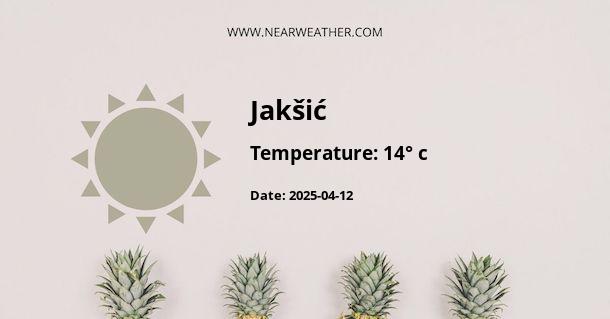Understanding the Climate and Weather Patterns of Jaksic, Croatia
Located in Croatia, Jaksic is a place that experiences a temperate climate with a significant influence from both the Mediterranean and Continental climate zones. Understanding the weather and climate of Jaksic is essential for residents, visitors, farmers, and businesses alike. The seasonal variations in weather conditions paint a detailed picture of what one can expect throughout the year.
Geographical Influences on Jaksic's Weather
Jaksic's specific geographical location has a pronounced effect on its climate. Proximity to the Adriatic Sea and local topography, including mountain ranges, valleys, and plains, play crucial roles in determining local weather patterns. Here's how these factors interact:
- Adriatic Sea: The sea moderates temperatures, especially in coastal areas, leading to milder winters and cooler summers compared to the continental parts of Croatia.
- Topography: Elevation and the presence of mountainous areas can lead to microclimates within the Jaksic region.
Seasonal Weather in Jaksic
Let's delve into the seasonal weather characteristics that define Jaksic's climate:
Spring
Spring in Jaksic is marked by a gradual increase in temperature and daylight hours. It is a transition period that sees the following conditions:
March begins with cooler temperatures, with a gradual warming trend moving towards May. Precipitation in spring is moderate, with occasional rainy days contributing to the blossoming flora.
Summer
Summertime brings warm and relatively stable weather, though heatwaves can occur:
Temperature averages range from comfortable to hot, and rainfall is usually less frequent but can include sporadic heavy thunderstorms, particularly in late summer.
Autumn
Autumn witnesses a cooling trend and an increase in precipitation as the season progresses:
September may still feel like summer, but by November, temperatures drop significantly, and the chances of foggy conditions and overcast skies increase.
Winter
Winter months are the coldest and can bring a mixture of precipitation types:
Snowfall is possible, particularly in the higher elevations, while frost and ice are more common in the valleys. January is typically the coldest month, with temperatures sometimes dropping below freezing.
Temperature and Precipitation Statistics
To provide a clear and factual understanding of Jaksic's climate, let's explore the average temperature and precipitation data:
| Month | Average High (°C) | Average Low (°C) | Average Precipitation (mm) |
|---|---|---|---|
| January | 3 | -3 | 60 |
| February | 6 | -2 | 55 |
| March | 11 | 2 | 60 |
| April | 16 | 6 | 70 |
| May | 21 | 11 | 80 |
| June | 24 | 14 | 100 |
| July | 27 | 16 | 70 |
| August | 27 | 16 | 80 |
| September | 23 | 12 | 90 |
| October | 17 | 8 | 80 |
| November | 10 | 3 | 80 |
| December | 5 | -1 | 70 |
Note: This table is based on historical averages and there may be variations from year to year.
Extreme Weather Events and Climate Change Impacts
Jaksic, like many other regions around the world, is not immune to the impacts of climate change and extreme weather events. An increase in the frequency and intensity of heatwaves, storms, and erratic weather patterns can be observed. These changes affect agriculture, water resources, biodiversity, and even human health.
Heatwaves
Increased temperatures during summer months can lead to heatwaves that not only stress the ecosystem but also have health implications for the elderly, children, and those with preexisting health conditions.
Intense Precipitation and Flooding
While summer months typically receive less precipitation, changes in climate patterns can lead to heavy downpours that cause flash floods and pose a threat to infrastructure and agriculture.
Droughts
Contrastingly, periods of low precipitation can lead to droughts, affecting water supply and agricultural productivity. Jaksic, being part of a primarily agricultural country, feels the impacts significantly.
Adaptation and Sustainability Measures in Jaksic
In response to these challenges, local authorities, communities, and businesses in Jaksic are adopting various measures to promote sustainability and resilience to climate change:
- Water Conservation: Efforts to reduce water waste and improve water management systems are in place to combat the scarcity during drought periods.
- Agricultural Adaptation: Farmers are gradually shifting toward crop varieties that are more resistant to drought and other climatic changes.
- Infrastructure Planning: Development of infrastructure is more and more taking into consideration the increased risk of extreme weather events, with investment in flood defenses and sustainable construction.
The accurate anticipation of weather conditions benefits from the extensive network of meteorological stations, satellite data, and climate models. Data from these sources are pivotal for the planning and management activities undertaken by various sectors sensitive to weather and climate.
Conclusion: Jaksic's climate is characterized by its blend of Mediterranean and Continental influences, resulting in mild winters, warm summers, and varied precipitation throughout the year. Understanding Jaksic's weather patterns is vital for various aspects of life and economy in the region. Moreover, adaptation to the growing challenges presented by climate change is critical for the long-term sustainability and prosperity of Jaksic and its residents.
A - Jakšić's Latitude is 45.358059 & Longitude is 17.763889.
A - Weather in Jakšić is 14° today.
A - Climate Conditions in Jakšić shows clear sky today.
A - Humidity in Jakšić is 56% today.
A - Wind speed in Jakšić is 5.83 km/h, flowing at 26° wind direction. today.
